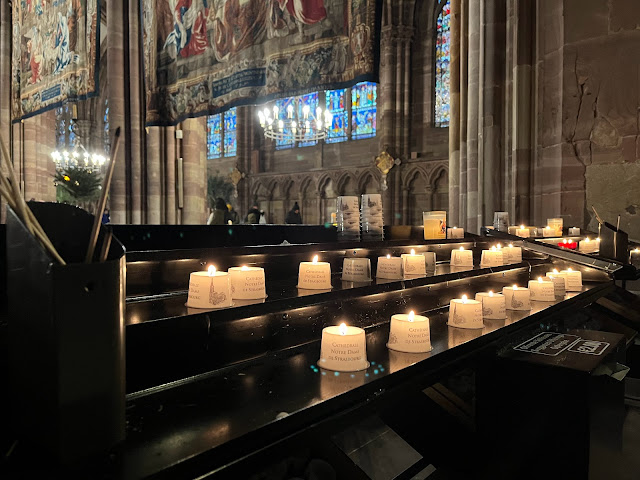Notre Dame de Strasbourg
Glenn and I, in the spirit of seeing more of France beyond Paris, took a short trip to Strasbourg earlier this week. We made time on our second day there to see the Notre Dame de Strasbourg, the city's cathedral. It was at once imposing and ethereal, if that is possible. (Victor Hugo said that it was a "skillful combination of monumental size and delicateness." True, I would say. Goethe said of its architect that he "was like the Great Architect who piled up mountains into the clouds.") Many better photographs exist than this one below, which I took. This view, though, does give an impression how one might be caught off guard turning a corner and catching a glimpse of this behemoth. Glenn, in the lower right corner, does not seem impressed, though. (For a more conventional photograph, you may visit, for instance, https://frenchquest.com/2020/07/17/goethe-and-the-strasbourg-cathedral/ and also read more on Goethe's views of the cathedral there.)
I have seen more churches in my life than I could possibly estimate, and even the grand and beautiful and famous ones run together eventually in my mind. This cathedral, though, stood out as something special. The endlessly intricate and pleasing gothic architecture, the earthy tones of the pink sandstone from the nearby Vosges Mountains, and just the magnitude were stunning. The interior was also special. Here is a photo of the very ornate pulpit. The photo at the top of the post is from near the pulpit as well. Apparently, millions of visitors have pet the small dog as they go by, giving it that bronzish hue.
Another view of the interior shows some votive candles with tapestries and leaded glass windows visible in the background.
Finally, by virtue of the timing of our visit, we were treated to the largest and most elaborate nativity scene I have ever come across, complete with dozens of figures, live plants, landscaping, and sophisticated lighting. ("Large" and "elaborate" were recurring themes of our visit to the cathedral.) These two photos capture, perhaps, one-sixth of the entire nativity.
A few years ago, I went to a talk given an MIT colleague of mine, Anne McCants. She studied the economic history of medieval Europe, and she said something that has stuck in my mind ever since: these cathedrals were not only the art museums and concert halls of their time, they were also the YMCAs of their time, a place where community could gather. And everything was free! One can certainly think that such huge expenditures on building monumental and elaborate structures might have been better spent on feeding the hungry and clothing the poor. But then to realize that the very best that society could produce in architecture, art, music, and technology was made freely available to the poorest of the poor through cathedrals like this casts the expenditure in a somewhat different light.











Lucina and I visited Strasbourg this summer for a day, and enjoyed the cathedral too! Your explanation of the economics of cathedrals is so interesting! I am reading a (fictional) book set in medieval Florence, and in one part of the story, the country people who come into town for a saint's festival spend the night in the cathedral.
ReplyDeleteIndeed! very interesting.
Delete